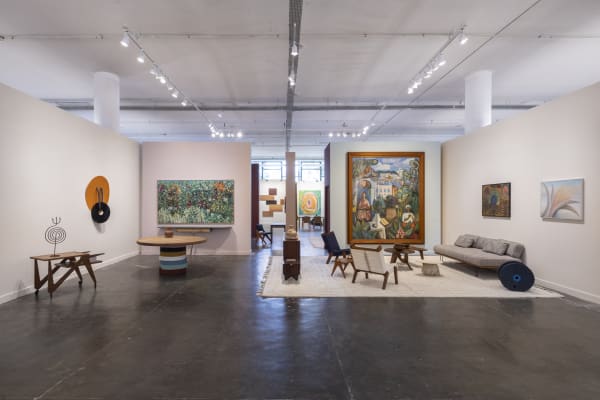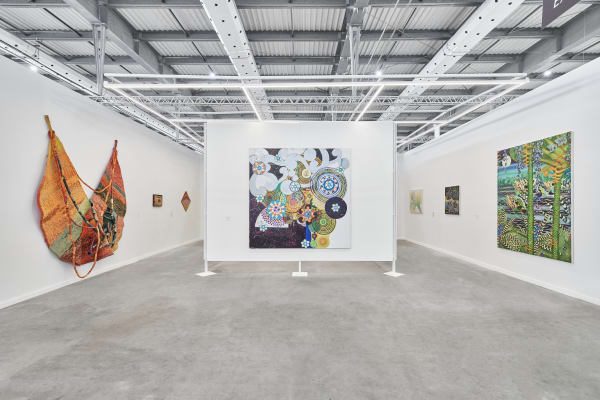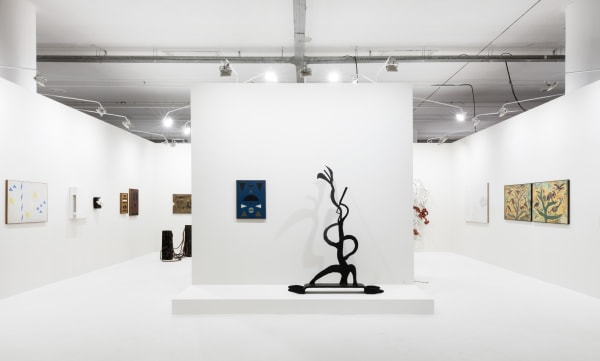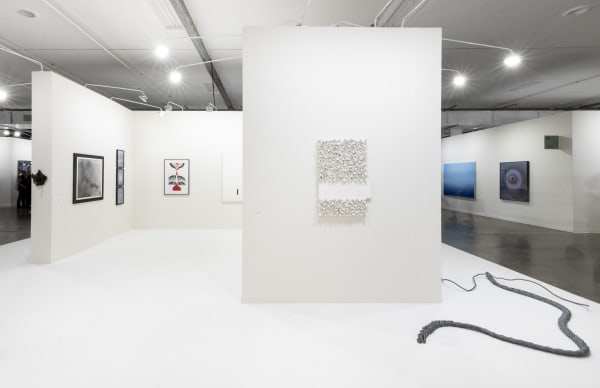Mira Schendel 1919-1988
Mira Schendel (1919 – 1988)
(Zurique, Suíça, 1919 – São Paulo, Brasil, 1988)
Was born in Zurich, Switzerland, in 1919, and grew up in Italy. Between 1930 and 1936 she took art courses at a free school and, according to herself, she drew compulsively during this period. In 1937, she entered the Università Cattolica del Sacro Cuore in Milan to study philosophy. With the intensification of fascism and anti-Semitism by the outbreak of World War II (1939-1945), she was forced to abandon her philosophy studies because of a decree-law that prohibited the enrollment of foreign Jews in higher schools; thus, in 1939, at the age of 20, she left Italy.
She moved continuously throughout Europe during a poorly documented period of her history, passing through countries such as Bulgaria, Hungary, Vienna, Croatia, and Slovenia. After the armistice in 1944, she moved to Rome with her then-Croatian husband Jossip Hargesheimer, where she worked for the International Organization for Refugees, which directed the emigration of the so-called "war displaced persons" to countries in the Americas. With this, Schendel and Jossip left Naples in July 1949 for Porto Alegre. In the city, she engaged in artistic studies, working on drawings, sculptures, and ceramics, and attended the Fine Arts School. At this time, she also learned graphic techniques at SENAI, and started working in a typography company and in other companies in the field. From 1950 on, she began to devote herself as never before to painting, a practice that, according to the artist, became a matter of life or death. In this phase, Giorgio Morandi's influence on the themes and palettes of her canvases, such as still lifes and earthy tones, is remarkable.
Her participation in the 1st São Paulo International Biennial, in 1951, provided her with international contacts and introduced her into the art scene of the time. Two years later, in 1953, she moved to São Paulo and adopted the last name Schendel. In her first years in the city, Mira approached the circle of thinkers that would soon become her friends and first critics - among them, Mário Schenberg, Haroldo de Campos, Theon Spanudis and Vilém Flusser. In 1955, she participated with her paintings in the 3rd São Paulo Biennial alongside Lygia Clark and Alfredo Volpi, having already held her first solo exhibition at the invitation of the São Paulo Museum of Modern Art.
In the early 1960s, she continued to develop her work in painting, which inclined towards more abstract and less figurative investigations than those of the 1950s. When Mira was presented with endless amounts of Japanese rice paper, she plunged into a series of experiments with this material and unleashed interests that took up a great deal of space in her artistic research, such as the expression of emptiness, the experience of time, being-in-the-world, and the mysteries of transparency. All this research captivates Mira in a way that leads her to paint less and less. Thus, starting in 1964, she created the series Monotipias [Monotypes], in which she drew in a peculiar way on rice paper - or, as the critic Rodrigo Naves says, she started to draw "from behind". In 1966, the series Droguinhas [Little Nothings] appeared, made with twisted and braided rice paper.
In 1967, she started to use acrylic in her works, as in the series Objetos Gráficos and Toquinhos. Also in this period, she began to work with Letraset decals, which became more prominent than the calligraphy explored until then. In 1969, she presented the installation Ondas palavras de probabilidade at the 10th Bienal de São Paulo - the work consists of nylon threads hanging from the ceiling to the floor accompanied by a passage of the biblical text from the Book of Kings printed on an acrylic plate attached to the wall. According to the artist, the work is an "attempt to show that the 'back side' of transparency is in the front and that the 'other world' is this one". Throughout the 1970s, she pursued her investigations on the process of "transparentization" of the world and of temporality. In 1974 she created the series Datiloscritos, in which she "drew" (typed) letters, signs, words, and sentences with a large cylinder typewriter.
In the 1980s, she vigorously recovers her interest in painting. She produced black and white tempera, the Sarrafos series, and began a series of paintings with brick dust. After her death, national and international institutions dedicated solo and retrospective shows to her, disseminating her work inside and outside Brazil. In 1994, the 22nd São Paulo International Biennial dedicated a special room to her. In 2007, her works participated in Documenta 12, in Kassel, Germany. Among the individual exhibitions held since then, the following stand out: Mira Schendel, Jeu de Paume, Paris, 2001; Tangled Alphabets: León Ferrari and Mira Schendel, Museum of Modern Art – MoMA, New York, 2008/Museo Nacional Centro de Arte Reina Sofía, Madrid, 2009/Fundação Iberê Camargo, Porto Alegre, 2010; Mira Schendel: avesso do avesso, Instituto de Arte Contemporânea, São Paulo, 2010; Mira Schendel – pintora, Instituto Moreira Salles, Rio de Janeiro, 2011; Mira Schendel, Tate Modern, London, 2013/Fundação de Serralves, Porto, 2014/Pinacoteca de São Paulo, São Paulo, 2014; Mira Schendel – Poesie in Letraset, Neues Museum Nürnberg, Nuremberg, 2014; Mira Schendel: sinais/signals, Museu de Arte Moderna de São Paulo, São Paulo, 2018.
Among the numerous national and international public collections to which Mira Schendel's works belong, notable ones include: The Museum of Modern Art – MoMA, New York, USA; Guggenheim Foundation, New York, USA; Pinacoteca de São Paulo, São Paulo, Brasil; Museu de Arte Moderna de São Paulo – MAM SP, São Paulo, Brasil; Museu de Arte Moderna do Rio de Janeiro – MAM Rio, Rio de Janeiro, Brasil; Museu de Arte Contemporânea da Universidade de São Paulo, São Paulo, Brasil; Tate, London, UK; Museo Nacional Centro de Arte Reina Sofia, Madrid, Spain; Henie-Onstad Art Center, Høvikodden, Norway; Kunstsammlungen der Stadt Nürnberg, Nuremberg, Germany.
-

Mira Schendel – esperar que a letra se forme
Instituto Tomie Ohtake – São Paulo 25 Oct 2024 - 2 Feb 2025Nesta mostra, estarão reunidas mais de 250 obras, entre pinturas, monotipias, desenhos, cadernos, objetos gráficos e uma instalação Esperar que a letra se forme é uma exposição-ensaio acerca da presença...Read more -

Todas as mulheres do mundo
curated by: Gabriela Mexias | BNPP's head office 26 Jan - 31 Mar 2024Read more -

Ocupação Mario Pedrosa
Itaú Cultural São Paulo 25 Oct 2023 - 18 Feb 2024O crítico para quem a arte era uma necessidade vital. O intelectual que, atento às novas maneiras de criação e expressão, foi – como disse o poeta Ezra Pound sobre...Read more -

Mira Schendel: Toquinhos
Critical essay: Lisette Lagnado 28 Jun - 19 Aug 2023 Galatea Oscar Freiresenza metafora [1] Lisette Lagnado — What is left of the tree after its trunk has been cut close to the ground? — A stump, or stub, informs the dictionary....Read more
-

Art Basel Miami Beach
Miami Beach Convention Center | Miami – EUA 5 - 7 Dec 2025Galatea and Isla Flotante are happy to participate in a joint presentation at Art Basel Miami Beach 2025 . Presented at booth F26 in the...Read more -

ArtRio 2025
10 - 14 Sep 2025Galatea is pleased to participate in the 15th edition of ArtRio , taking place from September 10th to 14th at Marina da Glória, in Rio...Read more -

SP-Arte 2025
2 - 6 Apr 2025Galatea is pleased to announce its participation at the SP–Arte 2025 fair, which will take place at the Bienal Pavilion, in Ibirapuera Park, from April...Read more -

ArtRio 2024
25 - 29 Sep 2024The Galatea booth at ArtRio 2024 presents a selection of works that reflects its artistic program. Showcasing a range of artists, from emerging talents on...Read more
-

SP-Arte 2024
3 - 7 Apr 2024Galatea is pleased to announce the participation in SP–Arte 2024, taking place at the Bienal Pavilion from April 3 to April 7, 2024. At our...Read more -

SP-Arte 2023
29 Mar - 2 Apr 2023Galatea’s booth for this edition of SP Arte will present works by artists that reflect our artistic program, featuring works by our represented artists, as...Read more -

Brazilian Threads
SP-Arte: rotas brasileiras 24 - 28 Aug 2022Galatea is pleased to announce the participation in SP–Arte Rotas Brasileiras, which will take place at Arca, between August 24 and 28, 2022. The project...Read more






